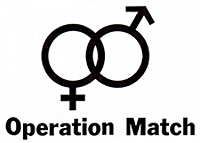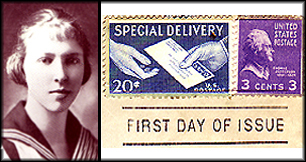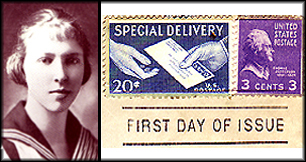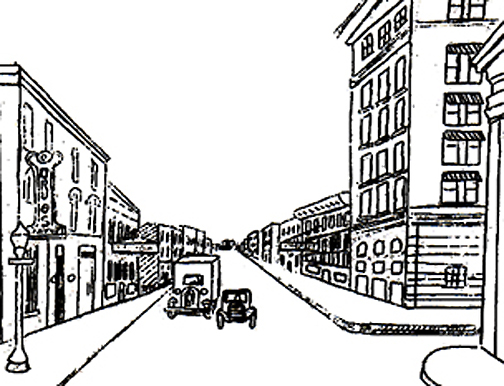Richard Jackson, a 1958 Science Hill High School graduate, permitted me to examine a 1921 Wataugan that he purchased from an antique store. It was a jewel.
The title page acknowledged this annual’s significance: “The Wataugan – Volume 1 – 1921 – Published by the senior class of Johnson City High School.” The book contained 61 pages including 32 pages of ads. One page showed two remarkable photographs: “Science Hill as it WAS” and “Science Hill as it is NOW.” Judging from the slant of “the hill,” the old school appeared to face south toward E. Market.
The new school faced N. Roan and seems to have been snapped before the students began classes there. Material, dirt piles and light snow appear all over the grounds. The 23 faculty members included Mr. D.R. Haworth, superintendent and Miss Lucy Hatcher, principal. Mrs. Will Lusk served as librarian and Miss Maude Hodge was school nurse.
Perhaps the most significant section of the periodical was the “Alumni Association Roll,” listing the names of school graduates between 1894 and 1921. (See complete list of names below.) Oddly enough, the class of 1910 is not shown. Does anyone know why? The class of 1894 had only seven students; the one for 1920 displayed 48.
Several prominent names appeared in the register, including possibly the most recognized alumni, LeRoy Reeves (1894), designer of the Tennessee State flag in 1905. Student Edwin Crouch masterfully penned an essay titled “Happy Valley – The Watauga,” that commences with these carefully chosen picturesque words: “The valley of the beautiful Watuaga, reposing like a vale of cashmere in the midst of green hills and towering mountains half veiled in the purple haze that is born of ‘magnificent distances,’ is one of those charming spots on earth.”
Three students shown in the photos became prominent doctors in Johnson City: Charles Gresham, William G. Preas and Carroll H. Long. The school’s calendar revealed two significant events for Feb. 9, 1921. The Wataugan became the official name for the annual and maroon and gold were adopted as the school colors.
Male students had a choice of four literary societies: Adelphian, Jacksonian, Jeffersonian and Wilsonian. The ladies boasted of seven: Athenian, Lanier, Pocahontas, Utopian, Victorian, Frances E. Willard and Ossolian. As always, the ads were interesting to read, such as this sampling of the 90 displayed in the back pages of the annual:
“The Hanks-Morris Motor Company – Distributors of Cadillac, Oakland and Overland.”
“Fountain Square Furniture Company – Johnson City’s Cheapest Store, At the Sign of the Rocking Chair.”
“East Tennessee Normal School – A school for the education and training of teachers, Expenses very low – Tuition free; Sidney G. Gilbreath, President.”
“The Liberty Theatre – Quality Plays.”
“Masengills – Have you seen the new models of Betty Wales Dresses, which we are showing? They are irresistible.”
“H.M. Smith Co. – You can get there walking, but you will get there quicker and with more ease if you ride a National Bicycle.”
Blanche Crigger laments her graduation from high school with this brief poem: “Turn backward, turn backward. O, Time, in thy flight. To my dear old school days. Just for one night.”
In upcoming columns I will feature sports and additional material from Richard Jackson’s remarkable find.
Science Hill High School Alumni
1894-1920
Class of 1894
Carrie Ball, W.R. King, Gertrude Mitchell, W.H. Gildersleeve, Sue Wood, (Miss) Willie Reeves, LeRoy Reeves.
Class of 1895
Laura Faucette, Leucretia Eubanks, Raymond P. Reeves.
Class of 1896
Mary Faucette, Neva Painter, Elizabeth Carr, Frank Mitchell, Earl Jackson, Will Pouder, Mamie Grant and Charlie Biddle.
Class of 1897
Haskiel H. Dyer, Fred W. Hoss, Josie Lusk, Luster Painter, Sanna Biddle, Frank Gildersleeve, Walter H. Hunter, Will N. Hoss, Ada Wood.
Class of 1898
Ailene Galloway, Beatrice Reeves, Mamie King, Stanley Reeves.
Class of 1899
Mattie Bullock, Alice Campbell, Paul B. Carr, Ada Darden, Arthur Erwin, Leola Martin, Jennie Lusk, Will B. Miller, Eva Lusk, Thomas Kirkpatrick, Walter J. Miller, Mamie Hickey, Lillie Painter, Lucy Pouder, Bessie Weaver.
Class of 1900
Almanda Boucher, Bessie Ball, Maxie Cox, Ethel Cloyd, Lillian D’Armond, Winifred Grant, Lula Hunter, Gordon Henderson, J. Foster Hoss, Clarence King, Mable Jackson, Joe T. Matson, Haynes Miller, Helen Mumpower, James A. Pouder, May Reeves, Carrie Snyder.
Class of 1901
Will E. Hatcher, Bessie Painter, Lowry Cary, Vest Cross, Ethel Smith, Jessie Dulaney, Edward M.S. Crumley, Mabel Davidson, Maude Lust, Lucy Hatcher, Ethel Beals, Eva Lyle, Lizzie Mitchell, Roxie Slaughter, Mack Smith.
Class of 1902
Charles Bullock, Jennie Austin, Lena Barton, James Beals, Olga Boyd, Walter Brown, Ella Burrow, Kate Carr, Regina Eiseman, Nellie Gammon, Grace Hart, Lora Hickey, Walter Hodges, Pearl Lyle, Maggie Martin, Ira Matson, Harry D. Miller, Nora Miller, Bob Mitchell, Virgil Slaughter, Nellie Wade, Graham Wilbourne, John Wood.
Class of 1903
Bertha Burgess, Nell Carr, Ollie Crowell, Bessie Chinouth, Marion Friberg, Robert Gammon, Mabel Gildersleeve, Mary Gildersleeve, Jennie Hatcher, Floyd Henderson, Marion Johnson, Sadye Malone, Guy Sabin, Mrs. Horace Burleson (no maiden name shown).
Class of 1904
Faye Whiteside, Thompsie Baxter, Anna Bell Beasley, Lena Hunt, Mary Willie Broyles, Mary Lyle, Hattie Hunter, Golden Wilbourne, Mary Evans, Nat G. Taylor, Elmer Beals, Ralph Cargille, Loyall Sitton, George Gildersleeve.
Class of 1905
Ella Russell, Faw Broyles, Claire Fulton, Lonnie W. McCown, Maude Beasley, Cecil Donnelly, Una V. Templin, Fred King.
Class of 1906
Roscoe A. Long, Leone Wagner, Mary Nell Beasley, Bonita Cloyd, Hazel Goode, Nora Hartsell, Ora Keys, Margaret Kegley, Georgia Seaver, Sarah Cordelia Tomlinson.
Class of 1907
Edith Barton, Ethel Barton, Mary Agnes Berry, Ruby Baxter, Henry Carriger, Margaret Culler, Lucy Carr, Eva Fulton, Kathleen Gaunt, Mary Hardin, Rhea Hunter, Dimple Mettetal, Walter Martin, Fa N. Matson, Bonnie Murray, Pansy Painter, Glennie Pence, Lucy Sitton, Guy O. Seaver, Bess Slaughter.
Class of 1908
Nellie Strain, Ralph Preas, Kate Gilmer, Alfred Gaunt, Ruth Lyle, Ward Friberg, Pearly Cloyd, Hubert Templin, Ina Bayless, Cleveland B. Coe, Julia Mettetal, Edith Tally, David T. Miller, Nettie Wallin, Chester Allen, James Buck, Issac Faw.
Class of 1909
John I. Hale, Will Barton, Emily Miller, Florence Dickey, Worley Harr, Ruby Hodges, Sarah Broyles, Edith Campbell, Loren E. Long, Nell Crouch, Katherine Wilson, Gladys Berry, May Tomlinson, Lucile Martin, Inda Houtz, Herbert Athey.
Class of 1910
(No names listed.)
Class of 1911
Mary Alicd Barton, Fannie Rhea Dosser, Margaret Dosser, Ida Deam Campbell, Violet Fontaine, Kate Lundy, Elizabeth Jones, Mary Long, Fred Peoples, Mattie Strain, Lois Peoples, Florence Sitton, Margaret Woodruff .
Class of 1912
Loftus Murrell, Edna Daniel, Hugh F.M. Hoss, Elizabeth Reeves, James Hardin, Susie Remine, Burr Harrison, Kathryn Peoples, Hallie Wolf.
Class of 1913
Grace Boring, Eleanor Brading, Earl Cloyd, Mary Nell Dosser, Paul Emmert, Prentice Fulton, Marion Bowman, Mamie Bryant, Elberta Cox, Byron Eiseman, Eleanor Exum, Henley Gilbreath, Marie Hannah, Hattie Hunt, Edgar Lyle, Harry Mitchell, W.A. Richardson, Mabel Sutton, Maude Tomlinson, Isabel Wade, Lee Harr, Hubert King, Sara McCown, Samma Slaughter, Gunnar J. Teilman, Pell Vance, Maurice Wilson.
Class of 1914
Frank Baxter, Whitney W. Buck, Reba Cannon, James Carter, Carrie Lee Cox, Hilda Evans, Nell Hyder, Charlie Lyle, Martha Mahoney, Margaret Moore, Bruce Preas, Kate Remine, Clyde Smith, Bessie Snyder, Nell Swingle, Melvia Taylor, Ellen Bowman, Ida Campbell, Leland Caldwell, Reba Collette, Andrea Daniels, Rivers Huddle, Edwin Long, Mary Gertrude Lyle, Roy Moore, Mary Dean Preas, Ruth Robbins, Arthur Moss, Miller Smith, Frank L. St. John, Mary Taylor.
Class of 1915
Helen Vance, Frances Byrd, Mattie Bolton, Louise Thomas, Edward Brading, Alfred Carr, Thomas Matson, Louise St. John, Robert Miller, Guy L. Smith, Mary Fulton, Cameleon Allison, Morris Cooper, Edna Vance, Stella Barlow, Earl Fields, Guy Williams, Agnes Dyer, William Thompson, Crumley Ervin, Irene Browning, John Parsons, Draxie Liebe, Nell Brown, Loren Estes, Williams Matthews, Christine Burleson, Orville Martin, Luke Hunt, Margaret Lyle, Martha Good, Robert Dosser, Nellie Hunter, Max Lusk, Arthur Watson, Elizabeth Cass, Howard Clark, David Wilson, Katherine Sells, Sam Smith, Hazel Dinkle, Irma Cooper, Ruth Banner, Earl Hotalen, Bryan Woodruff, Evelyn Armbrust, Harris Wofford.
Class of 1916
Ethel Riddell, Harry Faw, Edith Bolton, Earl Buchanan, Ernest Hodge, Leone Brown, Fitzhugh Wallace, Ruth McCorkle, Hannah Doak, Edith Clark, Clarence L. Miller, Reeves Hays, William Mitchell, Vance Jones, James Earnest.
Class of 1917
Ruth Barlow, Melville Smith, Tera Harshbarger, Alta Boring, Floyd Lockett, Yetta Hecht, Margaret McCown, Elizabeth Moore, Oliver Robertson, Pauline Tindell, Ben Conner, Mildred Wade, Maurice Caldwell, Georgia Pierce, Virgie Chitwood, James B. Humphreys, Ivah Baker, Mildred Nicholson, Paul Keys, Margaret White, H.C. Hart, Barbara Haire, Edith Baxter, Theodore Daniels, Ruth Allison, Anne Huddle, Nancy Weaver, Lorna Whiteside, Louise Cox, James Remine, Bess Remine, Blanch Wood, Buford Conner, Georgia Taylor, Carl Young, Helen Swan.
Class of 1918
Hattie Remine, K. Harshbarger, Hattie Tilson, Mary Shaffer, Dean Tainter, Vivian Nelson, Elsie Artz, Gertrude McCorkle, Margie Hunt, Estelle Snyder, Clyde McCall, Josephine Taylor, Mary Kyle, Bruce Lacy, Charlotte Matthews, Gertrude Hunter, Glen Hunter, Beulah Snyder, Mary Parrott, Spencer Leonard, Emma Louise Painter, Sophia Blair, Thelma Houston, Carmel King, Edith Lyle, Byron Garvin, Hattie Cox, Ada Evans, Paul Preas, Blanch Range, Helen McLeod, Ira Williams, Ernest Kite.
Class of 1919
Selma Bowman, Martha Carr, Carl Fields, Lucille Hartsook, Francis Miller, Sebra Cooper, Lester Keller, Anna Kate Culton, Cora Mae Crockett, Jaffa Gump, Don Gray, Nell Hanna, Margaret Hutchins, Howard Imboden, Lamonte Laher, Edith Mausbach, Aucil Barron, Evangeline Hartsook, Louise Nelson, Elizabeth Fisher, Ida Adams, Anna Baum, Rosa Baum, Kate Britton, Selma Browning, Paul Cox, Mary Emmert, Mary Ewalt Grace Estes, Edith Gilmer, Elbert Hardin, Leila Hart, Ogarita Keebler, Lorenia Moore, Helen Seaver, Kathryn Sells, Georgia Williams, Mary Lockett, Rosalie Buck, Elizabeth Martin, Ida Cox.
Class of 1920
Ruby Anderson, Fred Artz, Martha Bowman, Edith Campbell, Lest Leonard, Valerie Shipley, Edith Brown. Roy Lukk, Jessie Daniels, Juliet Hunter, Delno Diddle, Vera Chitwood, Sadie Freeman, William Whistman, Arthur Mae Smalling, Edna Dickey, Walden Shell, Helen Williams, Winnie Woodruff, Harry Fisher, Helen Lusk, Kathleen Martin, William Bailey, Leone Lacey, Rubie Haire, Eugene McSpadden, Claire Anderson, Elizabeth Parsons, William Erwin, Della Spencer, Ellen Moss, Andrew Martin, Zelma Keebler, Margaret Hayes, Theodore McCown, Mabel Dickson, Georgia Matthews, Robert Jobe, Cora Smith, Helen Faulk, William Hart, Ella Ross, Lena Gregory, Bert Wetherby, Mary Louise Miller, Mable Robertson, Arch Spencer, Ina Williams.
Class of 1921
Edwin Crouch, (Miss) Gordon Grubbs, Walter Smith, Martha Goode, William Roper, Belle Lyle, Albert Tipton, Jesse Masengill, Charlie Crouch, Sara Crigger, Victor Crouch, Ruby Sharp, Eugene Hunter, Ethel Chaffin, Ernest Thomas, Selma Luntsford, William Keen, Florence Stout, William Starritt, Kathryne Rangely, Leslie Hart, Lelia Hughes, Frank Clark, Mary McLeod, Robert London, Robert Brown, Mattie Weems, Charles Gresham, Ina Shafer, Ethel DeArmond, Helen Stapleton, Jack Lust, Loretta Pearce, James Bayless, Mina Medford, Stanley Brading, Bennie Artz, Elsie Hyder, Gladys Cox.







